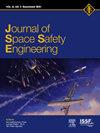针对潜在空间天气风险影响的安全管理系统的案例研究,针对来自加利福尼亚州莫哈韦航空航天港的高海拔“近空间”飞行运营商,以及相关的监管挑战
IF 1.7
Q3 ENGINEERING, AEROSPACE
引用次数: 0
摘要
莫哈韦航空公司太空港位于美国加利福尼亚州莫哈韦。它海拔2801英尺(854米),占地近3000英亩,有三条跑道。它获得了美国联邦航空局(FAA)的许可,可以进行可重复使用航天器的水平发射,并且已经成为航空航天研究和空间企业的主要枢纽,其中包括潜在的太空飞行和非常高海拔的亚音速、超音速和高超音速飞行。在潜在的高海拔“近空间”空间飞行期间,宇宙辐射暴露的影响,特别是在空间天气突然变化期间,如地面增强(GLE)或太阳粒子事件(spe),可能对机组人员和乘客的健康产生重大影响。本案例研究考察了莫哈韦航空航天港搭载一名或多名付费“太空飞行参与者”(非机组人员,搭载在运载火箭或再入飞行器上)的高海拔“近太空”太空飞行的辐射风险、监管挑战、许可复杂性和风险管理方法的复杂情况。该研究探讨了极高海拔飞行风险评估的具体挑战,详细研究了空间天气辐射环境在飞行计划和执行中对航天港和飞行运营商构成的风险。这项研究涵盖了“端到端”的发牌程序,以及太空港和飞行运营商对太空天气的监管考虑。此外,我们还研究了安全管理系统(SMS)的集成,即我们探索SMS框架如何主动识别、评估和减轻整个“近空间”空间飞行过程中的风险。此外,该研究还提供了一个解决飞行监管框架、风险评估、飞行前简报和飞行许可程序的模板。本案例研究为太空港和飞行运营商、监管机构和政策制定者提供了有价值的见解,有助于制定全面的安全战略,这对于安全的非常高海拔“近空间”空间探索至关重要。简单的语言摘要:一个案例研究如何成功地管理潜在的空间天气风险,从美国加利福尼亚州莫哈韦航空航天港运载一个或多个空间飞行参与者的非常高海拔的“近空间”亚音速、超音速和高超音速飞行。本文章由计算机程序翻译,如有差异,请以英文原文为准。
A case study into the safety management systems for the effects of potential space weather risks, for operators of very high altitude ‘near space’ flights from Mojave Air & Space Port, California, and the associated regulatory challenges
Mojave Air & Space Port is located in Mojave, California, United States. It is at an elevation of 2,801 feet (854 m), is nearly 3000 acres in size and has three runways. It is licensed by the FAA for horizontal launches of reusable spacecraft and is already a major hub for aerospace research and space enterprises, which includes potential space flights and very high altitude subsonic, supersonic, and hypersonic flights.
During potential very high-altitude ‘near space’ space flights, the effects of cosmic radiation exposure, especially during sudden changes in space weather, such as ground level enhancement (GLE) or solar particle events (SPEs), could have significant health implications for crew and passengers. This case study examines the intricate landscape of radiation risks, regulatory challenges, licensing complexities, and approaches to risk management for very high-altitude ‘near space’ space flights from Mojave Air and Space Port carrying one or more paying "space flight participant" (being an individual, who is not crew, carried aboard a launch vehicle or re-entry vehicle).
The study explores the specific challenges of risk assessment of very high-altitude flights, looking in detail at the risk posed by the space weather radiation environment in flight planning and execution, for both Space Port and flight operator. The study covers the ‘end to end’ licensing process and the regulatory considerations of space weather required for both Space Port and flight operator. Further, we look at the integration of Safety Management Systems (SMS), namely, we explore how SMS frameworks proactively identify, assess, and mitigate risks throughout the ‘near space’ space flight process. Further, the study presents a template for addressing the regulatory framework for flights, risk assessment, pre-flight briefings, and the flight licensing procedure.
This case study offers valuable insights for Space Port and flight operators, regulators, and policymakers, contributing to the development of comprehensive safety strategies, which are crucial for safe very high-altitude ‘near space’ space exploration.
Plain Language Summary: A case study of how the potential space weather risks can be successfully managed for very high altitude ‘near space’ subsonic, supersonic, and hypersonic flights from Mojave Air and Space Port, California, USA carrying one or more space flight participant(s).
求助全文
通过发布文献求助,成功后即可免费获取论文全文。
去求助
来源期刊

Journal of Space Safety Engineering
Engineering-Safety, Risk, Reliability and Quality
CiteScore
2.50
自引率
0.00%
发文量
80
 求助内容:
求助内容: 应助结果提醒方式:
应助结果提醒方式:


